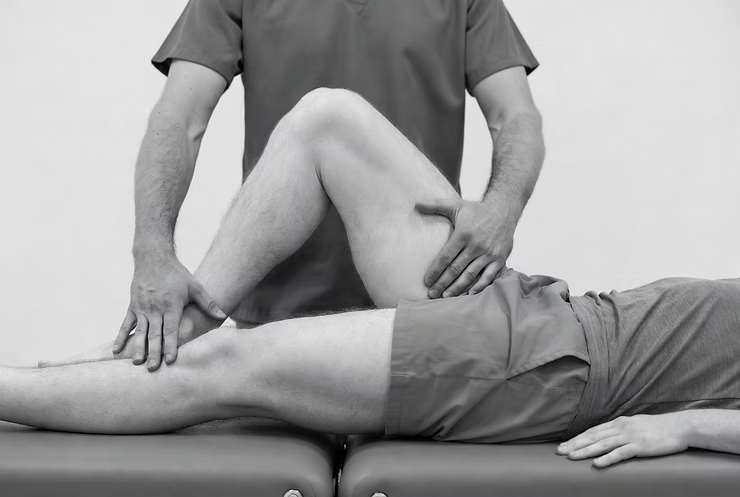Muller's test
- Fysiobasen

- Dec 18
- 3 min read
Muller’s Test is a clinical examination used to assess injury to the posterior cruciate ligament (PCL) and the degree of posterior laxity in the knee. The test is also known as the Quadriceps Active Test (QA-test) as described by Daniel et al. Its purpose is to identify posterior subluxation of the tibia relative to the femur and to evaluate knee joint stability. This test is important in the diagnosis of PCL injuries, which often occur from trauma to the anterior tibia or during sports injuries.

Advantages and Limitations
The advantage of Muller’s Test is that it is easy to perform in clinical practice without the need for special equipment. It provides quick information about PCL function. A limitation is that the test depends on the patient’s ability to activate the quadriceps muscle, and results may be influenced by pain, swelling, or other conditions that reduce quadriceps function. Therefore, the findings should always be interpreted in combination with other clinical tests and imaging for a reliable assessment.
Execution of the Test
The patient lies supine with the hip flexed to 45° and the knee flexed to 90°, similar to the posterior drawer test
The foot is placed in a neutral position and stabilized against the table by the examiner
The patient is asked to gently contract the quadriceps muscle without extending the knee
With quadriceps activation, the tibia is drawn forward from a posterior subluxed position to a more neutral alignment
This anterior translation is observed clinically and used to confirm the diagnosis
Assessment of Anterior Tibial Silhouette
As part of the test, the anterior contour of the proximal tibia is compared with the healthy side. The patient carefully lifts the foot off the table:
If posterior subluxation is present, the tibia initially rests in a sagged posterior position (“posterior sag”)
With quadriceps activation, the tibia glides anteriorly toward neutral
This anterior translation is a clear indication of posterior instability, and the degree of laxity can be compared with the contralateral knee
Evidence Base and Clinical Relevance
Muller’s Test has an evidence level of V (expert opinion and case reports). The QA-test is useful because it considers the effect of gravity, hamstring tension, and gastrocnemius activity, all of which may contribute to posterior tibial displacement. A positive finding is therefore not solely due to quadriceps weakness but may also reflect other muscular influences.
Muller’s Test is a valuable supplement to the posterior drawer and Lachman’s test when evaluating PCL injuries. In rehabilitation following PCL injury, strengthening of the gastrocnemius muscle may also be clinically relevant, as it contributes to tibial stabilization relative to the femur.
Summary
Muller’s Test, also known as the Quadriceps Active Test, is a simple and reliable examination for detecting posterior tibial subluxation caused by PCL injury. By observing anterior tibial translation during quadriceps activation, clinicians can assess posterior laxity and compare it to the unaffected side. While limited in evidence, it remains a valuable supplementary test in the clinical evaluation of PCL injuries.
Sources:
Daniel DM, et al. Use of the Quadriceps Active Test to diagnose posterior cruciate-ligament disruption and measure posterior laxity of the knee. JBJS. 1988;70A:386–391
Kieser DC, Savage E, Sharplin P. A Positive Quadriceps Active Test, without the Quadriceps Being Active. Case Rep Orthop. 2019;2019:1–4.
Gjennomgått - trukket
Rossi R, Dettoni F, Bruzzone M, Cottino U, D’Elicio DG, Bonasia DE. Clinical examination of the knee: Know your tools for diagnosis of knee injuries. Sport Med Arthrosc Rehabil Ther Technol [Internet]. 2011;3(1):25. http://www.smarttjournal.com/content/3/1/25









